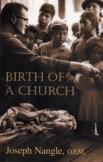New Life in Lima
This slender but powerful book describes how an upper-middle-class parish in Lima, Peru, was transformed in concert with the poor people in its midst, largely through the efforts of its founding pastor. The pastor, who is also the author of Birth of a Church, Joseph Nangle, O.F.M., recounts how this controversial transformation began and flourished. He does so primarily through stories about poor residents, some so powerful that the reader’s heart may well feel scorched by both the injustices and the hopes they illustrate. Indeed, the book begins with just such a story.
We see Father Nangle holding in his arms the body of a little boy, the child of an impoverished family, who had just been killed by a hit-and-run driver. “As I looked down at José’s face...he seemed to wear a kind of resigned expression, as if he had known that his life could end this way.” The wonder of the book, however, is that because of the efforts of the Franciscan team at Most Holy Name parish, the children of other poor families faced a far brighter future in their struggle with an oppressively rigid social and economic class system.
Currently co-director of the Franciscan Mission Service in Washington, D.C., the then-young Father Nangle arrived in Lima in the late 1960’s with the task of creating a new parish in a suburban enclave of Lima that was attracting upper-middle-class families. Energetic and outgoing, he and his fellow Franciscans soon had a growing congregation. Using pastoral methods familiar in the United States but new to Peruvian culture—like unannounced home visits—they came to know virtually everyone in Most Holy Name parish.
But after the initial honeymoon years, a dark reality pressed itself on the team’s attention as it began to understand the implications of the surrounding poverty. “We became increasingly aware of the relationship between those two cultures which made up Most Holy Name—the wealthy and the poor...and how they interacted or failed to interact.” The families in their large homes represented what Father Nangle calls the top tier of the parish’s tri-level social composition. The two lower levels were represented by the domestic servants and the caretakers who guarded the building sites of the new homes that were springing up. Unskilled and uneducated, both the latter groups existed in the oppressive shadow of their masters.
Determination to challenge this unbalanced situation led to one of the new parish’s most important early steps. At first, the parish school was attended only by the children of well-to-do parents who could easily absorb the considerable tuition costs. But in time, it was decided to offer afternoon classes to the children of the servants and the caretakers “after the rich little kids had finished their day.” The pastor realized, however, that this was tokenism. As time passed—especially after the meeting of the Latin American bishops at Medellín in 1968, which emphasized solidarity with the poor—he arranged for the children of the servants and the caretakers to be enrolled in school on an equal footing.
Although the move caused tensions, the parish council and the P.T.A. supported the new arrangement. Realizing that the children of the poor were handicapped by chronic hunger, a breakfast program was also added—another unheard-of step in that culture and time. Later, a night school for the parents of the poor children was created, and even a clinic to address their unmet medical needs. Parishioners who found such steps too challenging to the status quo left for more traditional parishes.
The wider world of Lima’s rigid social structure continued to ignore the poor. One of the most powerful stories tells of the author’s hurried trip to a hospital emergency room with a mother and her dying baby. The doctor told him to take the child to the local children’s hospital—clearly a ploy to avoid treating an indigent person. The child died en route. Realizing what had happened, the furious Father Nangle “went back to confront the doctor...threatening a malpractice law suit.” Here was a pastor to reckon with.
During his 11 years at Most Holy Name, Father Nangle resisted the cardinal’s urging that an elaborate church be constructed. Sunday Masses continued to be celebrated in the multipurpose auditorium, with weekday liturgies in the chapel of the Franciscan residence. He argued that “as long as we had sick, hungry, poor people around us, the Medellín vision of a preferential option for the poor...called into question spending money on ostentatious churches.” To his credit, the cardinal did not press the issue, nor did he have Father Nangle removed when letters of complaint poured into his office. The complaints took issue with the prophetic linea (thrust) that the parish had embarked upon. But he had his supporters. A parishioner-engineer who was an expert in designing earthquake-proof buildings saw how flimsy the adobe dwellings of the poor were and designed low-cost adobe houses that could survive when earthquakes struck.
Father Nangle celebrated his final Mass as pastor in 1975. His superiors had suggested that he return to New York to start a mission office for preparing and monitoring other Franciscans working overseas. But on his arrival, he learned that the position was not to be his, a decision that left him struggling with what he calls “the shock of rejection.” One suspects that the real reason lay in his uncompromising stance on behalf of the poor and his support of liberation theology—a stance that alienated many of his own fellow missioners as well as people in high places in Lima. One remains grateful, however, that Father Nangle has left an example of what a progressive priest can accomplish when allowed a free hand to act on behalf of—and in collaboration with—those whom the world considers “least.”
This article also appeared in print, under the headline “New Life in Lima,” in the March 28, 2005, issue.








